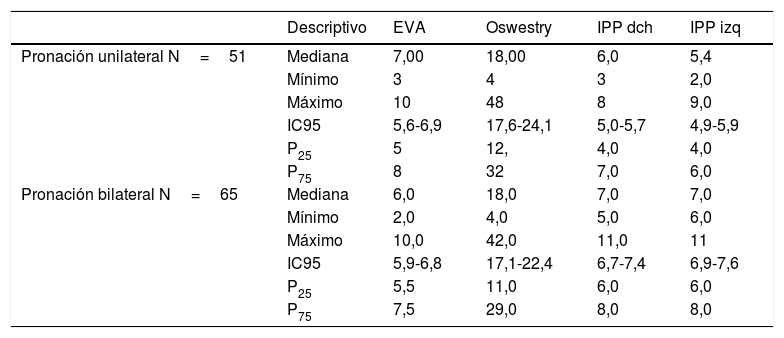Diferentes estudios han defendido la relación entre la pronación del pie y el dolor lumbar crónico (DLC). Sin embargo, no se hallan artículos que analicen la repercusión que puede existir entre la postura en pronación de un solo pie y su influencia en el DLC frente a la pronación en ambos pies. Por ello, se ha planteado evaluar la intensidad del dolor lumbar en sujetos pronadores con un índice de postura del pie (IPP) superior a+6 en un pie comparado con sujetos con pronación superior a+6 en ambos pies.
Material y métodoEstudio observacional transversal con muestreo por conveniencia en una muestra total de 116 sujetos. Se comparó el DLC en un grupo con dolor lumbar crónico y posición pronada de un pie (IPP, superior a+6), frente a un grupo de sujetos con DLC e IPP superior a+6 en ambos. Como herramientas de valoración de la variable dependiente se utilizó la escala visual analógica (EVA) y el Índice de discapacidad de Oswestry (IDO) para dolor lumbar.
ResultadosNo se encontró correlación entre la posición unilateral o bilateral en pronación y la intensidad del DLC. La pronación de un solo pie no pareció mostrarse como mayor factor de riesgo en el DLC que la bilateral (IDO p=0,700; EVA p=0,235).
ConclusionesNo se encuentran diferencias estadísticas en el DLC en el grupo de pacientes con un IPP del pie en pronación frente a los sujetos con posición en pronación bilateral. Futuros estudios son necesarios.
Different studies have defended the relationship between the pronated foot and chronic low back pain (CLBP). Nevertheless, according to current knowledge, there is no evidence on the possible influence of pronation of one foot or both feet and the intensity of the CLBP. The aim of this study was to evaluate the intensity of the CLBP in subjects with one or two pronated feet with a foot posture index (FPI, superior to+6) in one foot compared with subjects with CLBP and FPI of+6 in both feet.
Material and methodA cross-sectional study was conducted with convenience sampling, composed of 116 subjects who presented with CLBP and with two or at least one pronated foot. The CLBP was compared in one group with CLBP and one foot in the pronated position (foot posture index (FPI)>+6), against a group of subjects with CLBP and an FPI>+6 in both feet. The visual analogue scale (VAS) and the Oswestry low back pain index (ODI) were used as tools for assessing the dependent variable.
ResultsThere were no significant differences between the unilateral or bilateral foot pronation and the intensity of the CLBP. The pronation of only one foot does not seem to be a greater risk factor in CLBP than bilateral pronation (ODI: p=.700; VAS: p=.235).
ConclusionsThere is no evidence of a higher rate of chronic low back pain in the group of patients with a pronated position of one foot compared to subjects with both feet pronated, as assessed with the VAS and ODI scale. Further studies are necessary.
Artículo
Si ya tiene sus datos de acceso, clique aquí.
Si olvidó su clave de acceso puede recuperarla clicando aquí y seleccionando la opción "He olvidado mi contraseña".Comprando el artículo el PDF del mismo podrá ser descargado
Precio 19,34 €
Comprar ahora













